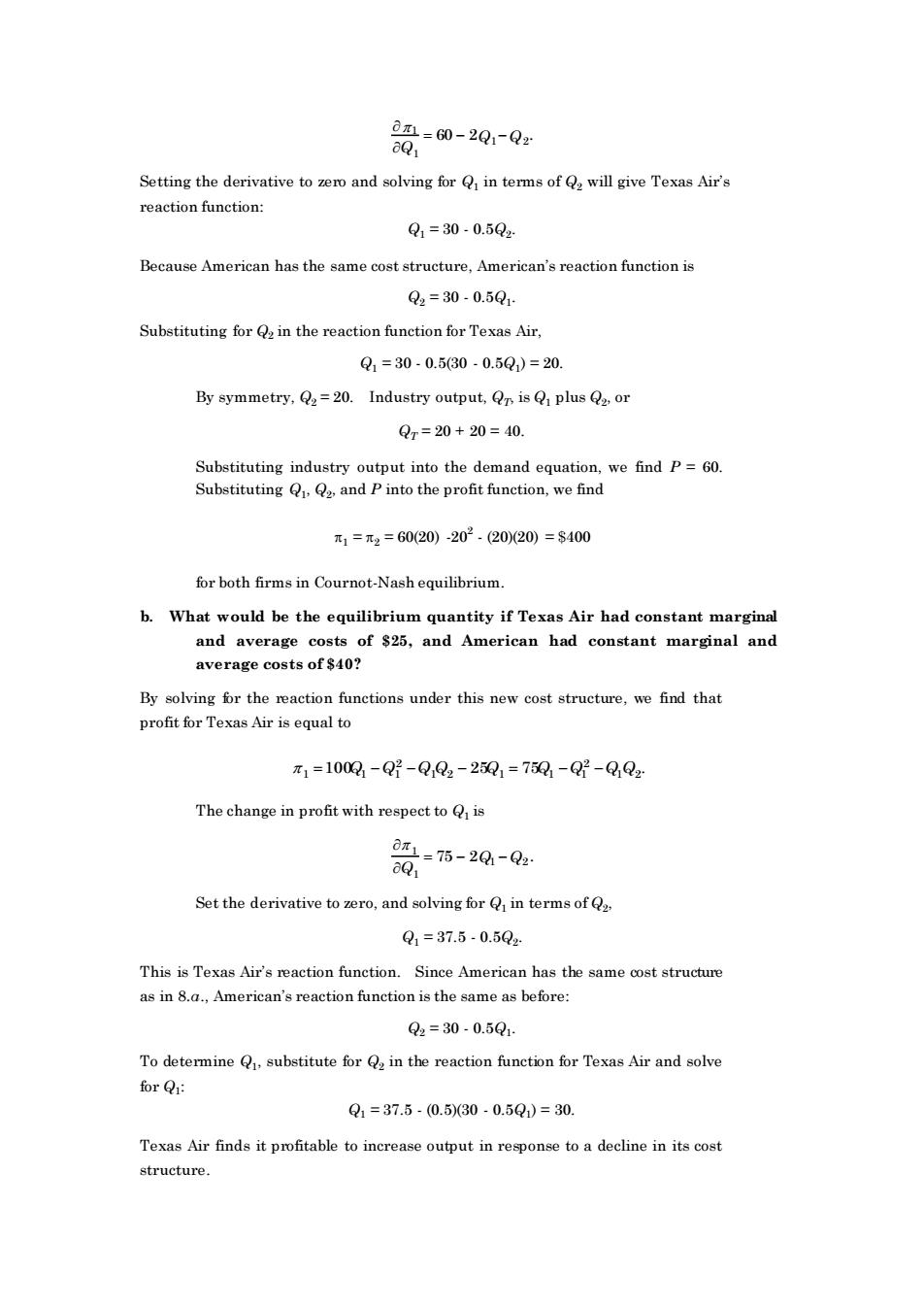正在加载图片...

沿=m-20-0: Setting the derivative to em and solving for in terms of will give Texas Air's reaction function: Q1=30.0.5Q2 Because American has the same cost structure,American's reaction function is Q2=30.0.50. Substituting for Q,in the reaction function for Texas Air, Q1=30.0.530-0.5Q)=20. By symmetry,Q2=20.Industry output,is plus Q or Qm=20+20=40. Substituting industry output into the demand equation,we find P=60. Substituting 2 and P into the profit function,we find 元1=元2=60(20)202.(2020)=$400 for both firms in Cournot-Nash equilibrium. b.What would be the equilibrium quantity if Texas Air had constant margina and average costs of $25,and American had constant marginal and average costs of $40? By solving for the reaction functions under this new cost structure.we find that profit for Texas Air is equal to 元1=1009-Q-Q102-25Q1=750-Qg-QQ2 The change in profit with respect to Q is 1=75-2Q-Q Set the derivative to ero,and solving for in terms of Q1=37.5.0.5Q This is Texas Air's reaction function.Since American has the same cost structure as in 8.a.,American's reaction function is the same as before Q=30.0.5Q To determine substitute forin the reaction function for Texas Air and solve for Q: Q1=37.5-(0.5)30-0.5Q1)=30 Texas Air finds it profitable to increase output in response to a decline in its cost = − − 1 1 1 2 60 2 Q Q Q . Setting the derivative to zero and solving for Q1 in terms of Q2 will give Texas Air’s reaction function: Q1 = 30 - 0.5Q2 . Because American has the same cost structure, American’s reaction function is Q2 = 30 - 0.5Q1 . Substituting for Q2 in the reaction function for Texas Air, Q1 = 30 - 0.5(30 - 0.5Q1 ) = 20. By symmetry, Q2 = 20. Industry output, QT, is Q1 plus Q2 , or QT = 20 + 20 = 40. Substituting industry output into the demand equation, we find P = 60. Substituting Q1 , Q2 , and P into the profit function, we find 1 = 2 = 60(20) -202 - (20)(20) = $400 for both firms in Cournot-Nash equilibrium. b. What would be the equilibrium quantity if Texas Air had constant marginal and average costs of $25, and American had constant marginal and average costs of $40? By solving for the reaction functions under this new cost structure, we find that profit for Texas Air is equal to 1 1 1 2 1 2 1 1 1 2 1 2 =100Q −Q −Q Q − 25Q = 75Q −Q −Q Q . The change in profit with respect to Q1 is = − − 1 1 1 2 75 2 Q Q Q . Set the derivative to zero, and solving for Q1 in terms of Q2 , Q1 = 37.5 - 0.5Q2 . This is Texas Air’s reaction function. Since American has the same cost structure as in 8.a., American’s reaction function is the same as before: Q2 = 30 - 0.5Q1 . To determine Q1 , substitute for Q2 in the reaction function for Texas Air and solve for Q1 : Q1 = 37.5 - (0.5)(30 - 0.5Q1 ) = 30. Texas Air finds it profitable to increase output in response to a decline in its cost structure